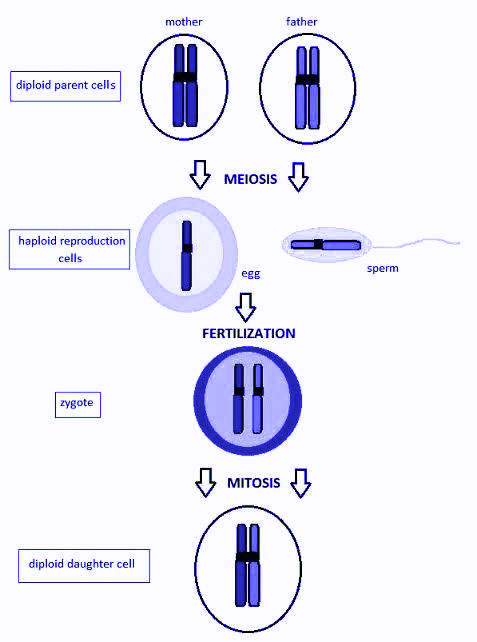Answer
393.9k+ views
Hint: Sexual reproduction is the type of reproduction in which new organisms are created, by combining the genetic information from two individuals of different sexes.
Complete answer:
In multicellular eukaryotes, sexual reproduction is the most common life cycle in animals, fungi, and plants. Sexual reproduction involves a complex life cycle. It consists of a set of events that are divided into the following three stages:
1. Pre-fertilization: (Formation & Transfer of Gametes)
This stage comprises the events before fertilization. The two events that take place during this stage are:
2. Gametogenesis of gamete formation
In eukaryotes, diploid mother cells divide to produce haploid cells known as gametes, in a process called meiosis. This process involves the recombination of genetic materials.
3.Transfer of gametes
Since the female gametes are immotile, male gametes are transferred for fertilization. In plants, this is achieved by pollination. Unisexual animals transfer gametes by sexual intercourse.
4. Fertilization: (Fusion of Gametes)
Two haploid gametes combine into one diploid cell to form a zygote, which is the precursor to an embryo offspring, in the process called fertilization. This zygote incorporates the genetic material from both the gametes. It is also known as syngamy.
5. Post-fertilization: (Embryogenesis)
Fertilization results in multiple cell divisions mitotically, without any change in the number of chromosomes, and forms a multicellular diploid phase that leads the zygote to develop into an embryo. This process is called embryogenesis.

Note:
1. The genetic diversity arising from sexual reproduction gives the species a better chance of survival. Sexual reproduction increases the diversity of genotypes and phenotypes within a population and allows natural selection to select for the individuals best suited to an environment.
2. Fertilization occurs either outside the body called external fertilization or inside the body called internal fertilization.
Complete answer:
In multicellular eukaryotes, sexual reproduction is the most common life cycle in animals, fungi, and plants. Sexual reproduction involves a complex life cycle. It consists of a set of events that are divided into the following three stages:
1. Pre-fertilization: (Formation & Transfer of Gametes)
This stage comprises the events before fertilization. The two events that take place during this stage are:
2. Gametogenesis of gamete formation
In eukaryotes, diploid mother cells divide to produce haploid cells known as gametes, in a process called meiosis. This process involves the recombination of genetic materials.
3.Transfer of gametes
Since the female gametes are immotile, male gametes are transferred for fertilization. In plants, this is achieved by pollination. Unisexual animals transfer gametes by sexual intercourse.
4. Fertilization: (Fusion of Gametes)
Two haploid gametes combine into one diploid cell to form a zygote, which is the precursor to an embryo offspring, in the process called fertilization. This zygote incorporates the genetic material from both the gametes. It is also known as syngamy.
5. Post-fertilization: (Embryogenesis)
Fertilization results in multiple cell divisions mitotically, without any change in the number of chromosomes, and forms a multicellular diploid phase that leads the zygote to develop into an embryo. This process is called embryogenesis.

Note:
1. The genetic diversity arising from sexual reproduction gives the species a better chance of survival. Sexual reproduction increases the diversity of genotypes and phenotypes within a population and allows natural selection to select for the individuals best suited to an environment.
2. Fertilization occurs either outside the body called external fertilization or inside the body called internal fertilization.
Recently Updated Pages
Basicity of sulphurous acid and sulphuric acid are

What is the stopping potential when the metal with class 12 physics JEE_Main

The momentum of a photon is 2 times 10 16gm cmsec Its class 12 physics JEE_Main

Using the following information to help you answer class 12 chemistry CBSE

Which of the following would not be a valid reason class 11 biology CBSE

Why should electric field lines never cross each other class 12 physics CBSE

Trending doubts
Difference between Prokaryotic cell and Eukaryotic class 11 biology CBSE

Fill the blanks with the suitable prepositions 1 The class 9 english CBSE

Write an application to the principal requesting five class 10 english CBSE

Difference Between Plant Cell and Animal Cell

a Tabulate the differences in the characteristics of class 12 chemistry CBSE

Change the following sentences into negative and interrogative class 10 english CBSE

What organs are located on the left side of your body class 11 biology CBSE

Discuss what these phrases mean to you A a yellow wood class 9 english CBSE

List some examples of Rabi and Kharif crops class 8 biology CBSE



